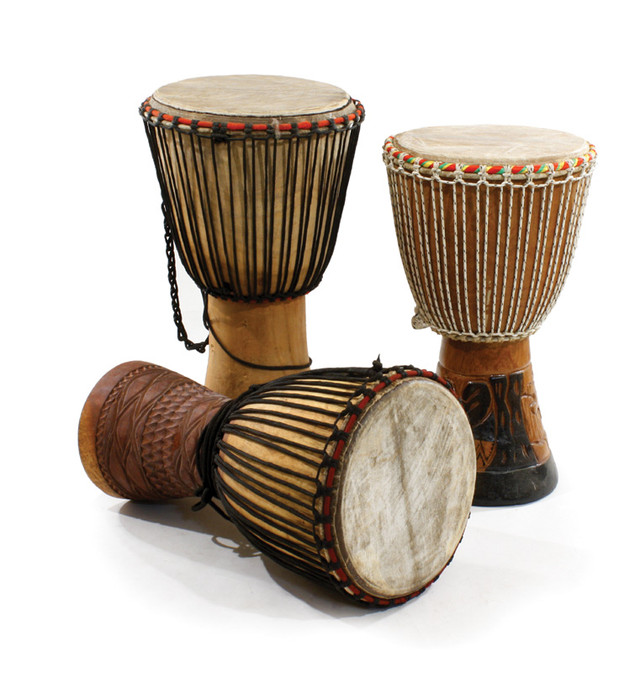
Music is a universal language that appeals to everyone, regardless of their background. One of the most fun things about music from around the world is finding unique instruments from different places and cultures.
Africa is a continent that is rich in musical traditions. One of the most interesting instruments to come out of West Africa is the djembe drum. The djembe is a beautiful, goblet-shaped drum that is traditionally carved from a single piece of hardwood. It is covered with an animal skin for its drumhead; and comes from western African nations such as Mali, Senegal, Guinea and Ghana. There is a rich history behind the djembe drum. Most experts believe that the djembe drum originated about 400 to 800 years ago during the Malian Empire. They believe that it was created by Mandé people.
The Malian Empire spanned a large swath of territory in what are today the countries of Senegal, southern Mauritania, Mali, northern Burkina Faso, western Niger, Gambia, Guinea-Bissau, Guinea, the Ivory Coast and northern Ghana. The area of the Mali Empire was referred to as Mande by its inhabitants. They were called the Mandinka (from Manden’Ka; which means people of Mande). They formed a federation of Mandinka tribe called the Manden Kurufa. That federation grew into an empire that ruled millions of people from every tribe in West Africa. The Mandé people developed the djembe drum with some specific purposes in mind. As in many cultures, music is used to signal a call gather together for prayer or a group meeting. It is also used to keep rhythm and pass the time during work. In fact, some believe that the name of the djembe drum came from the Bamana in Mali. They said, “Ankey dje, anke be.” That translates as, “everyone gather together.” Djembe is a combination of "Dje", which means to gather, and "be", which means everyone. Thus, the name djembe reflects the drum’s purpose in gathering people together. It is often used in ceremonies.
Not only is the name of djembe drum meaningful but there is also rich mythological tradition behind the creation of the djembe. The tradition teaches that the blacksmiths who created the first djembe drums custom made them for the drummers who would use them. The blacksmiths would cut down the tree used to make the drum. That was a spiritual act and the blacksmith would make an offering to the spirits of the tree. When a lenke tree was used for the drum, the blacksmith would make a sacrifice and ask for permission to cut the tree. Tradition also holds that each djembe drum contains three spirits. There is the spirit of the tree that supplies the wood for the drum. Then there is the spirit of the animal whose skin is used for the drumhead. Finally, the maker of the drum imbues the drum with their spirit. There is also a strong belief that the djembes are imbued with the spirits of the tribal ancestors. Some of the oldest djembe drums in existence contain the names of generations of djembe masters. The drummer is also an important part of the djembe drum tradition.
Traditionally the djembe was played by a member of the jeli cast. The members of the jeli cast would commission a djembe drum that was custom made for them. The jeli are a cast of musicians. They are responsible for more than music. They are the keepers of the oral tradition of their people. That is historically true and the tradition continues today. Tradition holds that the spirits of the djembe drum use the drummer as a vessel. The drummer is expressing the music of those spirits rather than owning the music. That takes years of careful study with a master to achieve. A djembe master will guide their student. They will teach their student the proper placement of their hands, fingers, arms and spine. They will guide their student’s thoughts and their spirits.
The masters take their responsibility to pass on both proper technique and the traditions of djembe drums very seriously. In time that passion allows their students to become masters as well! When you purchase a djembe drum you are becoming part of that tradition. Passing on the message of that tradition becomes part of the training. Where your drum comes from is important as well. Today many djembe drums are built in Ghana, Bali, and Thailand. These countries have greater industrialization and are able to produce greater numbers of drums but they are not part of the tradition. You should look for drums that come from the countries where the djembe originates and the trees that the drums have been traditionally made from grow: Guinea, Mali, Burkina Faso, Sierra Leone and the Ivory Coast. Djembe drums made in those countries will enable you have a drum with an authentic sound and spirit. We will be happy to help you find the right djembe drum for you as you embark on the traditional journey of a drummer! You can watch a video of an African craftsman making a D'jembe drum here
You can learn how to play a D'jembe drum from a master instructor here
 USD
USD  GBP
GBP  CAD
CAD  AUD
AUD 